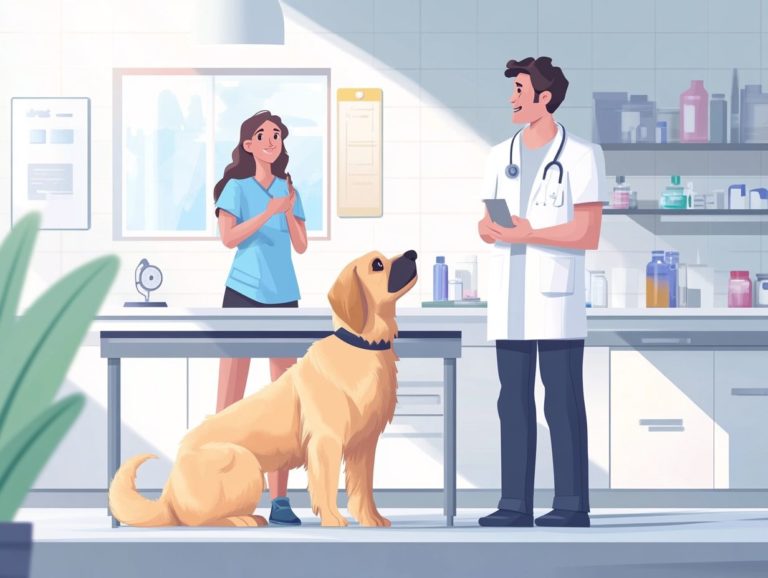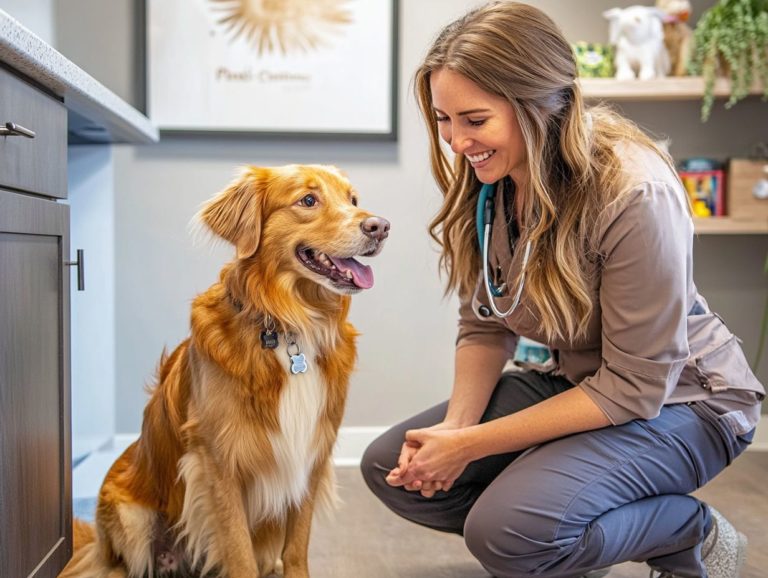Understanding the Role of a Pet Therapist
Pet therapy offers a unique and heartwarming way to enhance your well-being through the companionship of animals.
This article explores the essence of pet therapy, highlighting its remarkable physical and mental health benefits. It looks at the important role of pet therapists, the types of animals commonly used in therapy, and the qualifications needed to pursue this rewarding career.
Get ready to discover helpful insights just for you!
Contents
Key Takeaways:
- Pet therapy involves trained animals assisting individuals in improving their physical and mental well-being.
- The benefits of pet therapy include better physical and mental health, like lower blood pressure and less anxiety.
- To become a pet therapist, one must have the right qualifications and training while considering factors like the type of animal used and the specific therapy program.

What is Pet Therapy?
Pet therapy, often called animal-assisted therapy, is a purposeful intervention that fosters meaningful interactions between trained therapy animals and individuals, especially seniors. This helpful method has become valuable in various therapeutic settings, enhancing emotional stability and overall well-being.
This approach is particularly significant for those in senior care facilities or dementia patients. By creating companionship and easing feelings of loneliness, pet therapy provides essential emotional support while promoting social interaction, which strengthens family bonds.
The Benefits of Pet Therapy
Pet therapy offers a wealth of health benefits that can greatly improve your emotional stability and physical well-being, particularly for seniors and dementia patients in care facilities.
The presence of therapy animals can reduce feelings of loneliness, build companionship, and encourage social interaction, all while enhancing mental well-being and overall quality of life.
Engaging with animals in various therapeutic environments has shown to effectively manage stress levels, lower blood pressure, and alleviate symptoms related to heart disease. This underscores the profound positive impact these affectionate companions can have on your health.
Physical and Mental Health Benefits
The physical and mental health advantages of pet therapy are truly remarkable. You ll experience improved emotional support, increased companionship, and a significant decrease in loneliness, especially among seniors and individuals dealing with dementia. Regular interactions with therapy animals not only boost mental well-being but also encourage physical activity, essential for maintaining good health.
Research shows that having therapy animals around can lead to significant reductions in blood pressure and a lower risk of long-term health problems, making them invaluable allies for anyone facing chronic health issues. Imagine a joyful golden retriever visiting an assisted living facility; this friendly pup can motivate residents to engage in gentle activities like walking or playing fetch, keeping their hearts healthy.
The unconditional love these animals provide nurtures emotional stability, effectively lowering anxiety and depression levels. As seniors form bonds with their furry companions, they often notice significant improvements in their overall health. This highlights the undeniable power of companionship in enhancing one s quality of life.
Explore how pet therapy could transform your life today!
The Role of a Pet Therapist

The role of a pet therapist is crucial in enabling effective animal-assisted therapy. This role demands a mix of special tasks and skills designed to support individuals seeking emotional and physical well-being.
These professionals are not just skilled in handling therapy animals like dogs, rabbits, and guinea pigs; they also understand how to cultivate emotional stability and enhance social interactions among their clients.
By operating in diverse therapy environments, they facilitate meaningful interactions between seniors, dementia patients, and animals. This helps strengthen family bonds and fosters a nurturing atmosphere conducive to healing.
Responsibilities and Qualifications
Pet therapists have a range of responsibilities, such as managing therapy animals, crafting individualized treatment plans, and offering emotional support to clients across various therapy settings. To excel in these roles, specific qualifications and training are necessary to foster positive interactions between clients and their therapy animals.
This position requires not just technical skills in animal behavior and handling, but also an understanding of human psychology. As a pet therapist, you typically assess the unique needs of each client to customize your approach, creating tailored therapeutic experiences that resonate.
Focusing on emotional support, you guide both animals and clients through the therapeutic journey. This nurturing can significantly alleviate stress and anxiety.
Your educational background often includes degrees in fields like psychology or animal science, complemented by certifications in animal-assisted therapy. This blend of knowledge ensures you re well-prepared to tackle the emotional and psychological challenges faced by those you serve.
Types of Animals Used in Pet Therapy
In pet therapy, a diverse array of animals contributes to the therapeutic experience, each offering distinct benefits. While therapy dogs tend to steal the spotlight, cats, rabbits, and guinea pigs also play vital roles, especially in settings that emphasize emotional connections.
These animals are carefully selected for their temperament, companionship qualities, and their ability to foster social interaction. This is particularly important for seniors and dementia patients, who often seek emotional support to navigate their daily lives.
Dogs, Cats, and Other Animals
Among the various animals utilized in pet therapy, therapy dogs take the spotlight with their specialized training and remarkable ability to forge emotional connections with clients. However, don t overlook the charm of cats, rabbits, and guinea pigs; these delightful companions also play vital roles in the therapeutic process.
Imagine the joy therapy cats can bring! Their soothing purrs and gentle presence work wonders in easing anxiety for those grappling with mental health disorders. Meanwhile, rabbits, with their playful antics and velvety fur, offer a comforting distraction during challenging times. And let s not forget guinea pigs, whose sociable nature thrives on interaction, effortlessly spreading smiles and a sense of community in therapy settings.
Each of these animals brings unique qualities, enhancing emotional support and greatly contributing to improved mental well-being. Their presence is not just beneficial; it s transformative, making them invaluable in therapeutic practices.
How to Become a Pet Therapist

To become a pet therapist, one must blend formal education, specialized training, and a genuine passion for animal-assisted therapy. This combination equips you with the essential qualifications needed to support clients on their emotional and physical health journeys.
Aspiring pet therapists typically pursue degrees in psychology, social work, or veterinary studies, followed by focused training in animal behavior and therapeutic techniques. This commitment ensures you can facilitate meaningful interactions with therapy animals, ultimately enhancing the well-being of seniors and dementia patients in care facilities.
Education and Training Requirements
The education and training requirements to become a pet therapist are comprehensive and essential for ensuring you are well-prepared for animal-assisted therapy. Typically, you would pursue a degree in a relevant field followed by specialized training programs that focus on animal behavior, therapeutic techniques, and the emotional needs of working with clients.
Hands-on experience with animals is invaluable. You can achieve this through internships or volunteer opportunities at animal shelters and therapy programs, which will enrich your understanding and skills. Certification options may also be available, allowing you to showcase your competency and enhance your credentials in this growing field.
Understanding various psychological theories and honing your communication skills are critical, as your role involves fostering connections between pets and their human companions. Such well-rounded qualifications are essential for a successful practice, placing you in a prime position to make a meaningful impact.
Choosing the Right Pet Therapy Program
Choosing the right pet therapy program is crucial this decision can shape your career and impact many lives. It can profoundly influence your ability to foster emotional stability and health benefits for your clients.
Consider key factors such as the program’s curriculum, the qualifications of the instructors, and the opportunities for hands-on training with therapy animals. Assess how well the program aligns with your career aspirations and the specific therapy settings where you envision yourself working.
This careful evaluation will ensure that you receive a thorough education and the training necessary to thrive in this fulfilling field.
Factors to Consider
When selecting a pet therapy program, several key factors must be considered to ensure it aligns with your educational and career aspirations. You ll want to pay attention to the program’s accreditation, course offerings, practical training opportunities, and the qualifications of faculty members.
These elements shape both the quality of your education and your readiness to thrive in a competitive field. Accreditation is crucial, guaranteeing that the program meets established industry standards. A diverse range of course offerings will provide you with a comprehensive understanding of various therapeutic techniques and the psychological principles behind them.
Practical training opportunities provide real-world experience, allowing you to effectively apply your theoretical knowledge. The expertise of the faculty can greatly enrich your learning environment, creating opportunities for mentorship that enhance your professional development.
By focusing on these factors, you can better prepare yourself for a rewarding career in animal-assisted therapy.
Frequently Asked Questions

What is a pet therapist?
A pet therapist is a trained professional who uses animals to assist in the treatment and therapy of individuals with physical, emotional, or mental health conditions.
What is the role of a pet therapist?
The role of a pet therapist is to utilize the unique bond between humans and animals to promote healing, well-being, and positive change in individuals. They facilitate animal-assisted therapy sessions and work with clients to achieve specific treatment goals.
What kind of training do pet therapists have?
Pet therapists typically have a background in a mental health field, such as counseling or psychology, and receive specialized training in animal-assisted therapy techniques. They also have extensive knowledge of animal behavior and training methods to ensure the safety and well-being of both the animal and the client.
What types of animals can be used in pet therapy?
While dogs are the most commonly used animals in pet therapy, other animals such as cats, horses, birds, and even dolphins can also be trained as therapy animals. The type of animal used will depend on the specific needs and preferences of the client.
How does pet therapy benefit individuals?
Pet therapy offers numerous physical, emotional, and mental health benefits. It can significantly reduce stress and anxiety while boosting mood and self-esteem.
The presence of a therapy animal brings comfort and support during tough times. Imagine having a furry friend by your side when you need it the most!
Do pet therapists work with all ages?
Absolutely! Pet therapists work with people of all ages, from kids to seniors. They operate in various places like hospitals, nursing homes, schools, and rehab centers.
This variety allows them to provide valuable therapy to a diverse range of clients. No matter your age, pet therapy can be a wonderful support!






